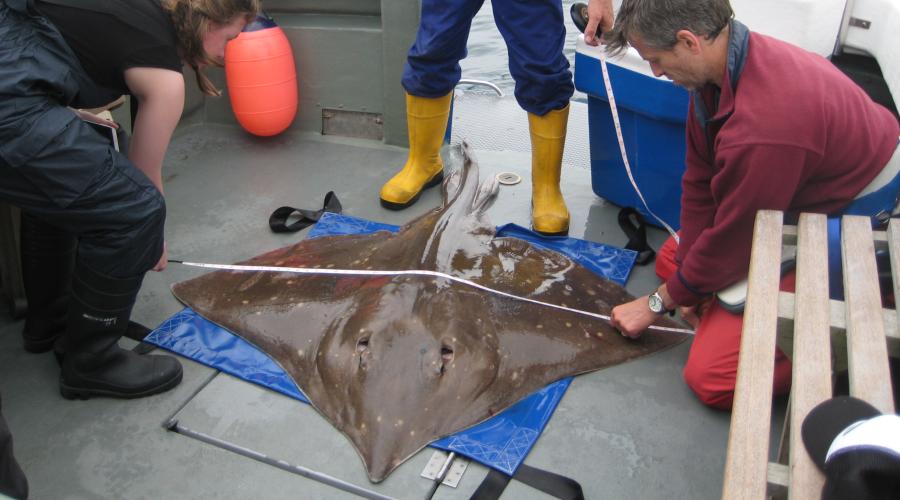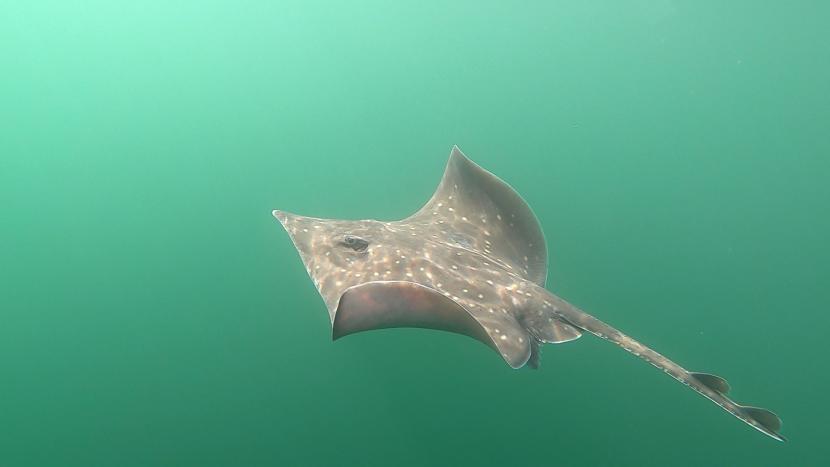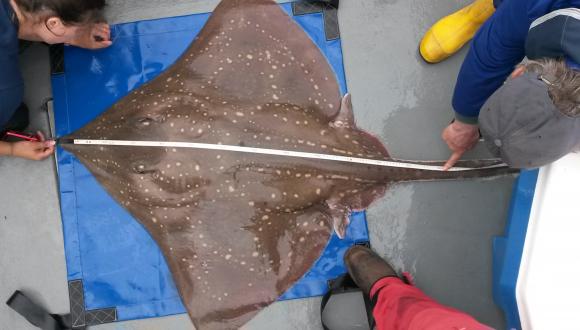
Flapper skate
These remarkable creatures of the deep were once common in British waters. Now only small populations remain, including in Scotland.
Flapper skate
The common skate complex (which includes flapper skate and blue skate) is categorised as Critically Endangered by the IUCN and both species have been described as extinct in large parts of their range following a long period of overexploitation. Flapper skate occur in significant numbers on the west coast of Scotland and in Orkney and Shetland and the species has recently begun to show signs of recovery throughout its range.
In 2010, it was found that the fish previously known as ‘common skate’ is actually two distinct species:
- flapper skate (Dipturus intermedius)
- blue skate (Dipturus flossada)
Flapper skates occur in the northern North Sea and off Scotland’s north-west coast. The smaller blue skate is the main species found in the Celtic Sea and around Rockall. The two species overlap across a wide area of the Celtic Seas ecoregion.
The flapper skate belongs to the elasmobranch or shark family. Instead of bones, it has a skeleton formed of cartilage. Adult flapper skate can reach up to 285cm (for the larger female sex) and seem to prefer deep (100m+) muddy habitats where they eat prawns and other skates and small sharks.

Flapper skate. (C)Fenella Wood, University of Aberdeen
Sensitivity of flapper skates and their eggs
Flapper skate take over 10 years to reach sexual maturity and produce low numbers of offspring and therefore the population will be slow to recover from any impacts.
Flapper skate eggs are large (width 10-14 cm, length 13-23 cm excluding horns) and have a tough outer coat which protects the embryo during development. Previously, little was known about where flapper skate would lay their eggs, but recent observations indicate that a seabed of boulder and cobble in relatively shallow waters is favoured and that eggs remain on the seabed developing for over a year before hatching. The eggs can be sensitive to activities and disturbance while they are on the seabed – for example by abrasion from ropes or chains (such as scouring by mooring chains) or by towed fishing gear being smothered by silt, and incidental capture in fishing gear.
Baby skate hatch at around 28cm in length and are vulnerable to being caught accidentally in mobile fishing gears such as trawls and dredges. Adults unable to avoid mobile gear may also be vulnerable. Gear modification such as the removal of tickler chains has been shown to reduce accidental skate capture significantly.
Protection of flapper skates
Sea anglers travel from all over the world for a chance to catch the flapper skate. All angling for this species in Scotland is on a ‘catch and release’ basis.
In 2009, it became illegal to land flapper skates and blue skates commercially in Scotland. Fishermen are required to return flapper skates unharmed as quickly as possible.
Loch Sunart to the Sound of Jura Nature Conservation Marine Protected Area was designated in 2015 to protect the resident flapper skate population. In 2016, it became illegal to fish using towed gears in certain parts of the NCMPA. In other areas fishing is allowed seasonally provided tickler chains are removed from trawls
Flapper skate are also a Priority Marine Feature and given policy protection under the National Marine Plan.
In March 2021 Red Rocks and Longay urgent MPA was announced to protect flapper skate upon discovery of an area of egg-laying habitat being used by a number of females. A range of activities are prohibited from the site while further research is undertaken to develop a proposal for permanent protection.
A critically endangered flapper skate has been successfully cared for and hatched in captivity in what is thought to be a world first for the species.
Studying flapper skates
Data provided by anglers through tagging projects dating back more than 30 years has been invaluable in protecting the flapper skate and continues to help us protect them.
In 2016, we trained charter skippers offering skate fishing trips in Loch Sunart to the Sound of Jura NCMPA to tag skates with passive integrated transponder tags. This helps us to monitor the size of the flapper skate population in the NCMPA.
We also collaborate with the Scottish Association for Marine Science on Skatespotter, a database for skate photo ID in Scotland and where anyone can upload photos of skate from anywhere in Scotland.
In 2016/17, NatureScot and Marine Scotland Science attached acoustic and data storage tags to flapper skates to learn about their fine-scale movements. A large amount of data generated by this project is the subject of a PhD at St Andrews University but you can read a short report on the project.
Non-anglers can help us to understand where skates breed by looking out for skate egg cases on beaches. Find out what to look for and how to submit your findings on the Shark Trust Great Eggcase Hunt website.
Video from a lecture given by Dr James Thorburn, Marine Science Scotland - 'Following Scotland's sharks : The common skate and the spurdog' - September 2017.
Credit: NatureScot
Steven Benjamins - Scottish Association for Marine Science giving a lecture on 'Seeing Spots
Find out more
News release - Flapper skate protection
News release - World first as endangered skate egg hatches
Poster - How to take a good photo of a skate for ID
Read our guidance for planners and developers on protected animals.
Presentations:




